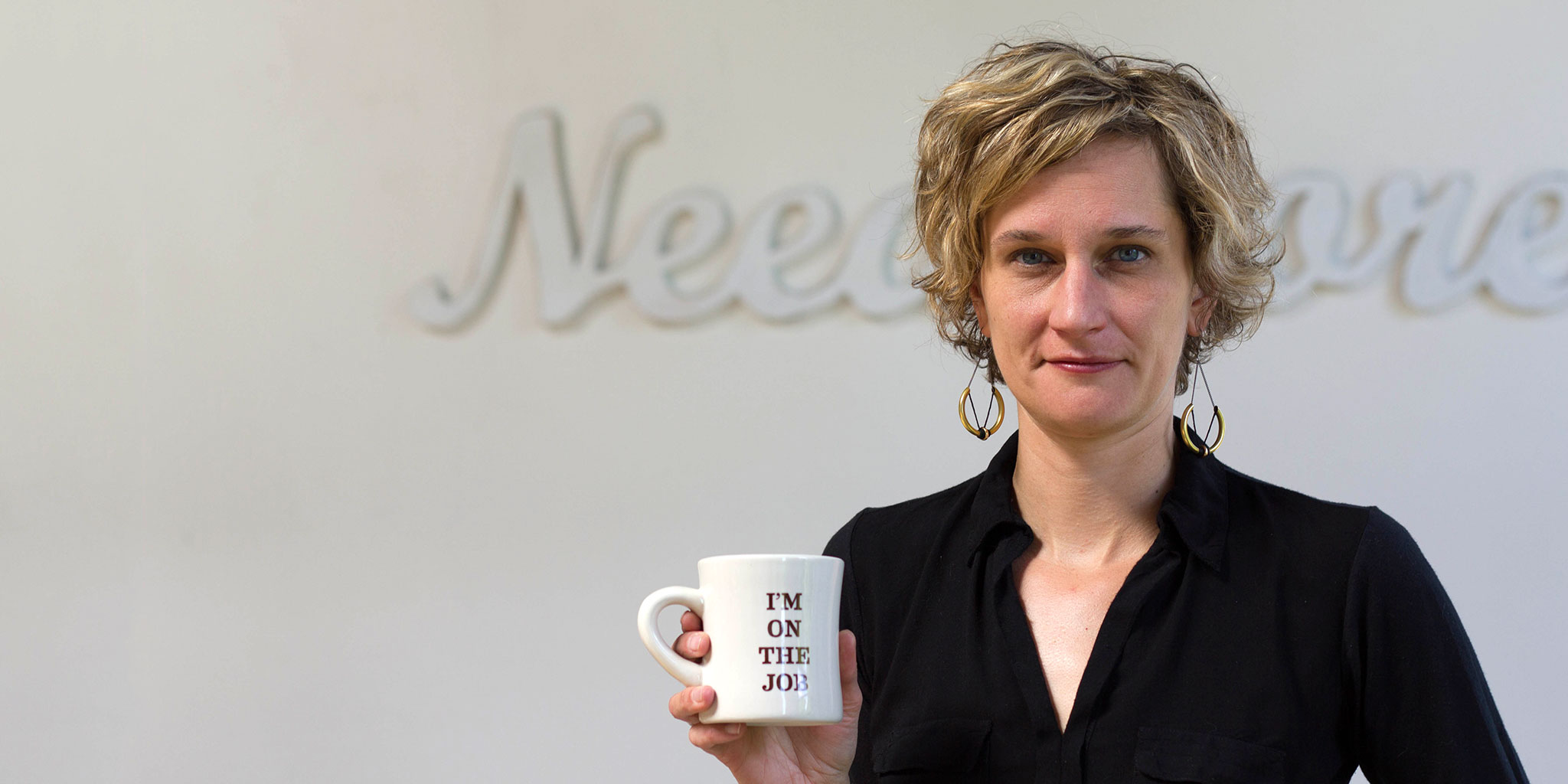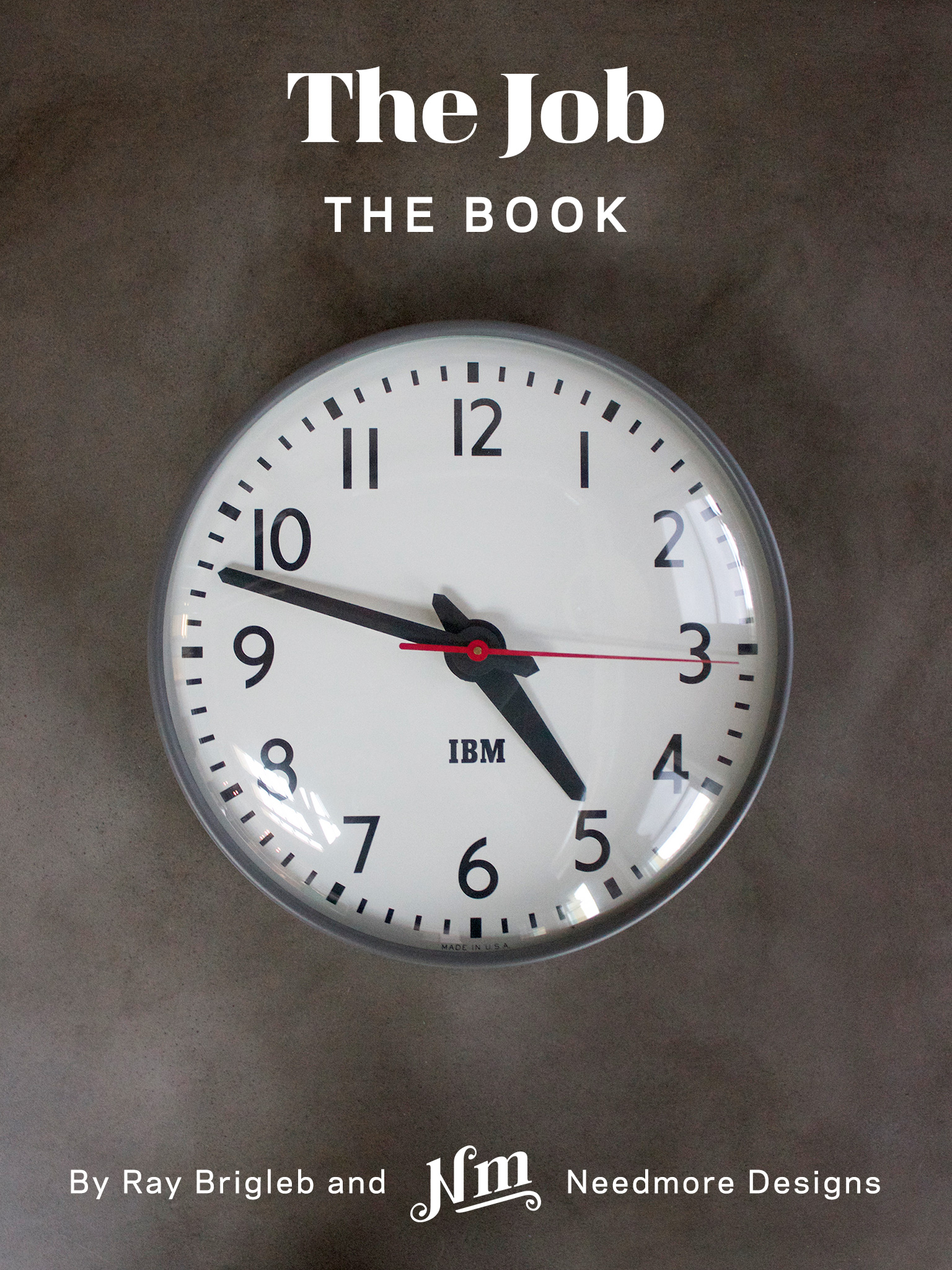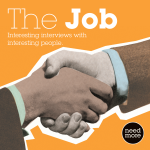
Camas Davis is a former editor (and vegetarian!) who now runs the Portland Meat Collective.
- Portland Meat Collective
- Portland Meat Collective Facebook
- CamasD on Twitter
- The New York Times Magazine article
The Interview
- Ray:
- Camas?
- Camas:
- Yes.
- Thank you for coming down today.
- Thank you for having me.
- I’m really honored to have you. I’m very excited to talk to you. We have a mutual friend who’s been raving about your classes, and also I just think you have a really interesting story, so why don’t we start. Are you originally from around here?
- Yes, hence my name, which is a flower that grows here in Oregon and Washington. I’m from outside of Eugene, Oregon, in a little farming community called Alvadore.
- Okay. I’ve done a little reading, and it seems like you spent a lot of time in the world of magazines and such publications.
- Yeah.
- This was generally sort of food-related writing?
- Mostly for the last, I don’t know, five-six years of the ten years that I was in magazines it was food.
- Okay. I think the most recent one was … I have so many notes. Was it the Portland Monthly? I’m going to say the wrong one.
- Yeah. That was the last staff job I had with a magazine.
- From there, how did you get to the point where you decided to start the Portland Meat Collective?
- It was a long process. When I left Portland Monthly, I wasn’t sure that I didn’t want to go back to magazines, but I knew that I wanted to take a break and do something with food that was elemental and transparent and down and dirty essentially. For me, that was not cheese-making. For me, that was butchery. I had been thinking, I think before I left Portland Monthly. I had been writing about meat a little bit, just in terms of … I was a restaurant reviewer, so I would go to restaurants and I would eat a cut of meat that I loved but didn’t see in butcher shops, didn’t see in grocery stores. I started writing about these cuts that I was finding in restaurants but that consumers couldn’t find and asking lots of questions of chefs and the meat distributors in town and then farmers.
What I found out in the process of researching those cuts was that there was a real lack of knowledge about where they came from. Most of the chefs I was talking to were not doing whole animal butchery. They were ordering a bavette steak, and it would come in boxes and they would open it and cook with it.
- In order to figure out what part of the animal that cut came from, I would have to go to the chef, then the distributor that sent the meat to them, then, if I was lucky, maybe the farmer or maybe the meat processing facility. By the time I got to that point, no one knew other than the meat processing facilities, and they weren’t talking to me.
- Right.
- I was sort of interested just from a journalistic perspective about who knows this stuff. If most of us on the consumer end of things are just opening boxes of cuts, where’s the chart? Where’s that hanging up? Then in addition, I was also interested in the fact that the cuts that I wanted to know more about were considered European cuts and not American cuts, and I wanted to know what that meant. By that, it’s really they were calling them by European names. Not like we didn’t have those cuts in America, but we had way less sexy names for them than the Europeans did.
I’d kind of been writing about that, those cuts and doing research and just thinking about where does all this come from, who knows what. Then when I left Portland Monthly, I started just thinking about what is a skill in the food world that I don’t have that I want to have, that could be practical, useful, and it could also sort of elucidate an entire world that’s invisible to me, and to me, that was butchery.
- When you were doing this, you would go from the chef to the distributor and you’re kind of going up the chain, so to speak.
- Mm-hmm.
- What kind of dead-end did you hit? Was it just that you were at the point where you were facing a factory that was never going to let you look at where the meat came from?
- Yeah. I would go to the chef; I would go to the distributor. The distributor usually bought from a central processing facility, and the central processing facility was where all these farms from all over, not necessarily Oregon farms, were selling their whole animals to. Between the farmer and the processing facility, between the farmer and the slaughterhouse, that’s where the knowledge was kept, basically.
- Yeah.
- Unfortunately, most of those central processing facilities are humongous and do not want to talk to the public, and are nervous.
- Sure.
- Maybe because they’re doing things not very well or maybe because there’s a lot of connotations attached to killing animals for food. Yeah. What I ended up having to do was go to chefs who were buying whole animals directly from farmers where there was no middle … Yes, the animals were going to slaughterhouses, but they weren’t getting further processed. Then it was the chefs who were doing whole-animal butchery that started to teach me, oh, there’s all this … There’s all this stuff that they get to do with the whole animal if they have that control, and all of this knowledge that they have to find in order to deal with a whole animal in their restaurant that they didn’t have to deal with or think about or explore when they were just opening boxes, box cuts, essentially.
- Mm-hmm. I think a lot of people maybe are … don’t even realize there’s a difference between a slaughterhouse and a butcher, between those two jobs. What point did you even realize that? Or that you could actually get the whole animal having been …
- Yeah. I didn’t realize how divided the labor was in America until I actually went to France, where I worked with a family that didn’t divide any of that labor. They owned every part of the process of getting meat to the table. They grew all the grain themselves to feed their pigs. They grew their own pigs. They owned a cooperative slaughterhouse with other farmers, and they took part in the slaughter. They did all of the further processing, making retail cuts. They did all the curing, making their own hams and bacons. Then they sold it all at markets. Here was this model that was completely opposite from what I had experienced in America, which was farmers taking every single part, taking part in every single part of the process.
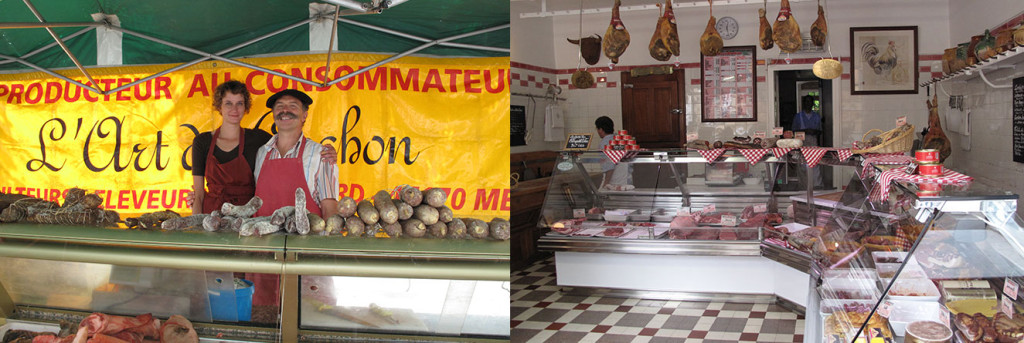
Camas at a market in France.
- Mm-hmm.
- When I saw that, I realized, oh, wow, farmers in America do not- Once their animal goes to the slaughterhouse, they’re done. They don’t have any say. Yeah.
- Is there anyone here who does what you saw in France?
- Yeah. Yes and no. There are definitely … We’re lucky in Oregon to have lots of farmers that do sell directly to consumers or restaurateurs. They’re not doing the slaughter themselves; they’re usually taking the animal to a slaughterhouse or they are hiring someone to come and slaughter on the farm. They are marketing directly to restaurants and to individuals such that they actually have to know what the cuts are called and they have to help consumers. If you wanted to buy a quarter cow from Farmer Joe, you’re probably going to say, well, what’s in a quarter cow? What cuts do I get? How much weight is there? How much of it is bones? The farmer is going to have to know how to talk that talk.
We do have that in Oregon, but it’s very rare. Ninety-nine percent of the animals that are raised for food in America are factory-farmed and part of this very divided labor pool, and then one percent is farmers selling directly to consumers who aren’t doing factory farming. It’s rare, but that one percent is what inspired me, and what I saw in France is what inspired me to start the Portland Meat Collective.
- Okay. Excellent. You’re going right according to script. No, I’m just kidding.
- Great. Perfect.
- When you came back here, this idea was in your mind. What was the journey here between when you came back and when you started the meat collective?
- When I came back from France, I actually didn’t have the Portland Meat Collective model in my mind yet. What I thought was, oh, I’ll come back, I’ll start a whole animal butcher shop like the family in France.
- Okay.
- Or I’ll start a bacon cart or I’ll do something sort of on the retail side. What I wanted to do on the retail side was to use the whole animal like the people in France did and sell the whole animal. What I quickly realized was that we don’t have a consumer base here to support that kind of model. When I was in France, most of the consumers we sold to, which was all at outdoor markets, if they came and asked for a pork chop and we were out of pork chops but we had pigs feet, they would buy the pigs feet. They wouldn’t flinch. It was just, oh, that’s another part of the pig; I would eat that. Here, not so much. We want the pork chop, we want the bacon, we want the ham, but the rest of that freaks us out.
I thought, well, if I ever want to open a whole animal butcher shop or do anything with whole animals on a retail side, I would have to have a consumer base. In order to have a consumer base, you need to have a much more educated consumer base. In order to do that, you need to create some kind of transparent education system for them in which they see, all right, if you’re going to eat a whole animal, this is everything that goes into eating a whole animal, the kill, the cleaning, the processing, all the organs, what you do with them. You have to really help people understand that a pig is a pig; it’s meat and fat and bone, all of it. There’s no difference between any of it other than how much a muscle moved or didn’t or that kind of thing.
- Mm-hmm.
- To me, it was more important to create that consumer base. At the same time I was in France and had learned a little bit of butchery and charcuterie and whole animal utilization, but I was by no means a pro. I wanted to keep learning, and I wanted to recreate what I had learned in France here and create that kind of hands-on, transparent education for myself and then for my community.
- When you started, did you have an idea of the type of person who would want to be a student of that? If so, were you surprised by who actually became students?
- Yeah. I figured … Because I lived in New York for awhile and had sort of seen meat, how whole animal butchery and meat became a bit trendy and the next big thing in food. Actually, when I arrived back from France, the New York Times had written an article declaring the butcher is the new rock star. That was happening when I came back. I thought, well, I’ll probably just get a bunch of young 20-something kids who like to work on farms and butcher whole animals, that’s what I thought.
- Mm-hmm.
- In fact, it’s been the opposite. Not even the opposite, it’s been just all across the board. Ages from high schoolers and younger to 70-80-90-year-olds, single parents, married parents, liberals, conservatives, hunters, lot of hunters, lot of fishermen and women, students. We’ve had people who work in the meat industry who, say, work at a Safeway meat counter or a Fred Meyer meat counter come to us because they don’t ever get to see the whole animal, so they come to learn that from us. Yeah. Doctors, lawyers, students, grandmas, grandpas. It’s sort of everywhere, which has been great, which indicates that across the board, people want to know where their food comes from. Right?
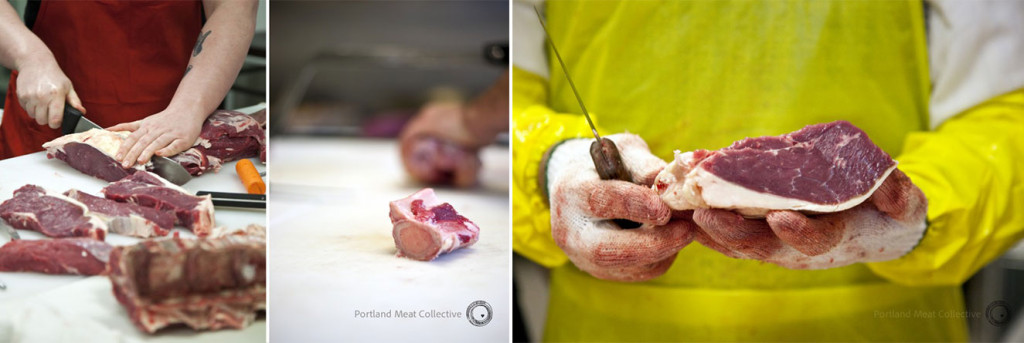
Portland Meat Collective
- Sure. Yes, definitely. I’m curious. You sort of touched on this when you were talking about going to these factories, that they want to keep a low profile because they’re slaughtering huge numbers of animals, and a lot of people have a lot of controversial feelings about that. It’s a very charged issue. However, almost by definition, what you’re doing is pretty high profile and although it’s not the same thing, it’s in the same area. Obviously, you must have expected to be somewhat of a lightning rod for people’s strong feelings about this. Has that been helpful? Has it been frustrating? Were you surprised by that? Did you kind of know this was going to happen?
- No, I didn’t know at all.
- Okay.
- I really went into it like, hey, there’s these two sides of the spectrum. There’s really militant vegans and then there’s all these people just eating meat and not thinking about it. Surely, if I create a dialog in the middle, everyone will just come to the middle and talk and be smart about it. When, in fact, that’s sort of been in some ways the opposite case. My goal in starting it was just to say on either end of that spectrum, what’s being completely left out is the processes by which meat gets to your table, and there are two kinds. There’s the bad kind and there’s what a lot of people call the good kind. It’s either factory farming or it’s that one percent. It’s the ninety-nine percent or it’s the one percent, that’s what I always say.
A lot of the reaction to meat-eating is … A lot of the angry reactions to meat-eating are in response to that ninety-nine percent, the factory-farmed, the inhumane treatment of animals, the over-eating of meat. All of that I think is important to be angry about and to talk about, but there’s very rarely room for alternatives. There’s very rarely room for anything in between. Just ignorantly eating factory-farmed meat and going full-bore vegan. Full-bore vegan; I guess that doesn’t really work.
To me, it was, well, what’s in the middle there? Then, of course, my philosophy about what’s in the middle is, well, if you are going to eat meat or you are going to try and eat less meat or better meat or whatever, you’d better know everything about where it’s coming from; you’d better embrace every part of the process of where that meat is coming from; you’d better be honest with yourself and the people around you how that meat got to your table. I think there’s an increasing number of people who do want to be honest about it and grapple with it and try and kill their own chicken and see if it works for them or not.
A lot of people do not want to go there, and it’s even meat-eaters, which is so fascinating to me. I get the angry vegans and whatever; that makes sense. It’s the meat-eaters that get mad at us for doing what we do. They think that what we do, which is showing people how to kill a rabbit, for instance, or showing them what to do with a pig head, how to make a pig head into food, which all meat, fat and bone, it’s all part of the same animal. That to them is gross, bizarre, psychopathic, exotic, whatever, but buying meat in Styrofoam packages from an unknown source that came from a really scary place, that’s not exotic, that’s not the horror film.
- Mm-hmm.
- What we do is the horror film to them. That seems really backwards to me, and that was surprising to me. I really thought that …
- People were reasonable?
In creating transparency, people confront transparency. As it turns out, transparency is, I think, very scary for people. It’s not only transparency about the bad stuff like factory-farmed; it’s transparency about killing an animal for dinner. Whether or not that’s bad or not is up to an individual, I think.
- Yeah, so it was surprising to me. I didn’t go into it trying to be a lightning rod, but here we are.
- Mm-hmm. It was a friend of mine who was very, very activist and was very much against factory animal treatment who convinced me to be a vegetarian in high school. I was a vegetarian for a long time and then a vegan. At some point, probably about a decade ago, I came back to eating meat again, partly because of the movement that what you’re describing is part of.
- Mm-hmm.
- Because I felt like I could start to understand and people were starting to be accountable, that American food culture was kind of undergoing a change. Do you have any personal experience similar to that?
- Yeah.
- That’s the worst leading question ever. Does this ring a bell?
- I, too, was a vegetarian. Yes. I grew up in Oregon. I grew up in a farming community. I grew up hunting and fishing with my dad and my grandpa, and that’s the meat that we ate growing up. Then we moved into Eugene, the big city, as my dad likes to call it, and my parents got busy. My dad stopped hunting. We started buying meat from the grocery store. Eugene, for me, I don’t know how much my fellow young people really understood factory farming or not, but most of them came from a counterculture background. Their parents had turned vegetarian in the ‘70s. I was just sort of surrounded by a vegetarian lifestyle, so I became one. There was no, oh, my god, I can’t believe they’re doing this to the chickens. It was, oh, well, everyone else is eating tofu so I’m going to eat tofu too.
Then after that, I started … Because my parents were still eating meat and asking me what the hell I was doing, I had to then come up with some arguments about why I was a vegetarian. Then I started becoming conscious about factory farming and that kind of thing. I did start eating meat again, obviously, in my college years, mostly because I was a terrible vegetarian and had a very poor diet, which is not all vegetarians; I just was bad at it and became really anemic and decided to just start eating meat again. That’s not an argument against vegetarianism.
- Sure.
- Then my job became reviewing restaurants and I had- I didn’t have to, but I did want to be able to write about the meat dishes. I went through a period of just … Even when people were starting to become more conscious about alternatives to factory-farmed meat, I was just eating meat and not thinking about it for a long time. Pretty much up until I went to France. I had always struggled with, okay, where am I on that spectrum? Do I want to hunt for all my own food? Do I want to be a vegan? Do I not care? Do I just want to buy meat from wherever? Do I just want to buy organic? We have so many choices now. It wasn’t clear to me which of those choices was real, if that makes sense.
- Mm-hmm.
- Which of them were reactionary and, I don’t know, sort of a way to feel better but not actually an answer to the problem.
- Right. In your classes or the classes that are taught at the Collective, do you feel as if understanding the factory slaughterhouse sort of experience, do you think that’s important to a student in the class? Is that part of the class?
- Yeah. We always talk about, okay, the animal we’re butchering today was raised this way.
- Okay.
- This is always. Because where we’re getting animals from, this is not common. The way animals are usually raised are factory-farmed model. If you took a factory-farmed pig and put it next to this pig, here are the differences that you would see. The factory-farmed pig, the muscles would be watery, they would be pale, they would not taste like much. This pig that’s moved around all of its life and fed a varied diet and been allowed to be a pig and move around … I keep using pigs because that’s usually what we’re working on. This pig has muscles that are much redder in color, less moist, tougher maybe but more flavor. This pig has more fat; this one has less fat. We show them the differences in terms of quality of meat.
We also always talk about how animals are slaughtered and how, depending on how stressful or not that experience is for the animal, that affects the quality of the meat as well. Then, of course, we also talk about all of the animals we’re working on in our classes, the farmer gets it slaughtered on the farm or at a local slaughterhouse, drives it to us, we’re done. Factory-farmed meat, by the time we get … We can’t really get a whole animal from a factory farm. By the time it would come to us, it’s ground and it’s come from 20 different places. We don’t actually know what animal it came from. We really try to talk about … show them how hard it is to understand where that factory-farmed burger patty came from versus a whole pig in front of you that came from a farm down the street.
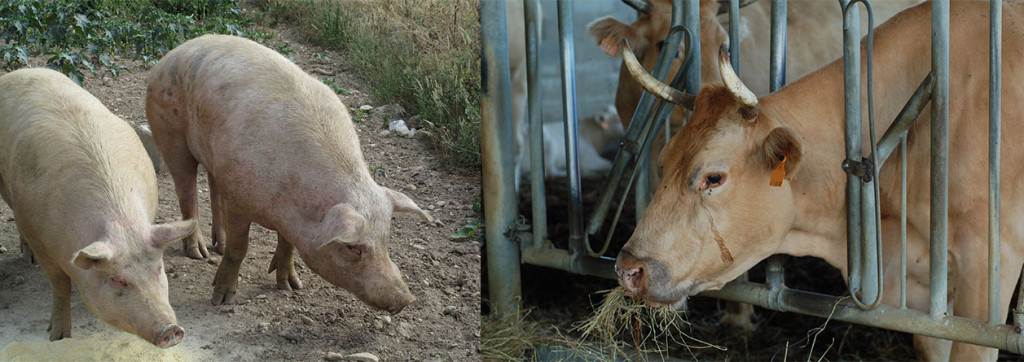
- Mm-hmm.
- I think it is important. Our goal is to in our classes try and get people to basically stop buying factory-farmed meat and start buying whole animals directly from farmers. They may or may not want to butcher it themselves, but we can help them figure out, okay, if you buy a whole animal, these are the cuts you’re going to get, this is how you can use it, this is how you can make it last, how you can do use preservation methods to make it last longer, and here’s a butcher that you can trust that will help you, break that down for you and fill your freezer that way. It’s a very different mindset if you’re going to try to use a whole animal, buy whole animals from local farmers, and then also make it worth your money and your time. Yeah. We definitely try to always talk about those differences.
- What year did the Portland Meat Collective start?
- I founded it in 2009, and I think we had our first class in early 2010.
- Okay. How has it been going?
- Great. I’m shocked at what’s happened with it. I really thought, you know, I’ll do a couple of classes here and there every year, and it will mostly be for me and my friends and that’s about it. We do four to six classes a month. They sell out within hours of announcing them. We have waitlists for classes. Now, we have people all over the country who want to start their own meat collectives, so we just launched a whole non-profit to help other people start them.
- Yeah. I saw you did a Kickstarter.
- Yeah.
- Was that part of this? How did that go?
- Great. Yeah, we did a Kickstarter last year. We used a lot of that money to help the Olympia and Seattle Meat Collectives start in Washington state. Then the rest of that we’re using to build, basically to write a guide, a sort of e-book guide to how to start a meat collective in your community. Then building a website that will be a place where all sort of meat collective constituents, be it owners, students, farmers, instructors, can come and converse and exchange information and advice. We’re working on the technical parts of that now.
- Yeah. That’s sort of the business model, just setting these up in different cities now?
- Yeah. I’m basically open sourcing the model. I’m not interested in franchising. I’m not interested even in being a consultant. I like the model. I want it to exit in the world. I started it on unemployment basically. I started it with nothing. I made it a sustainable model such that each class pays for itself. I think it can be a really great way for different kinds of communities, be they urban or rural, to bring together local farmers, local butchers, and then consumers who want to buy in kind of an alternative economy of meat. Then the overarching sort of philosophical part of all of this is, okay, so we’re teaching people how to … If they still want to eat meat, but they don’t want to eat factory-farmed meat, we’re teaching them what it takes to eat the non-factory farmed meat, what that requires of them.
Then when you start to buy whole animals from farmers, when you start to butcher them yourselves or even just use all of the parts, you kind of start to value meat differently. It’s not this thing that you always have access to; it’s a special thing. You pay a little more money for it. If you butcher it yourself, you work hard to get those cuts into your freezer. It kind of becomes a special occasion or special privilege or an accent to a meal versus this main course for breakfast, lunch, and dinner that we buy for 99 cents from the store every day. It really changes your whole notion of meat and what role it plays in your diet and your everyday life and that kind of thing. That’s the broad strokes, sort of abstract thing that happens to our students when they take our classes.
- It seems like not taking that for granted, that being something special, it almost seems like perhaps in a way you’ve come full circle to your childhood when food was hunted and brought home.
- Mm-hmm.
- Rather than just coming from the store.
- Yeah. Definitely.
- Maybe you’ve finally recaptured-
- A little bit of that, yeah.
- Little bit of that.
- I’m trying to learn bow hunting again.
- There you go. Thank you, Camas, for talking to me today.
- Yeah. No problem. Thanks for having me.
